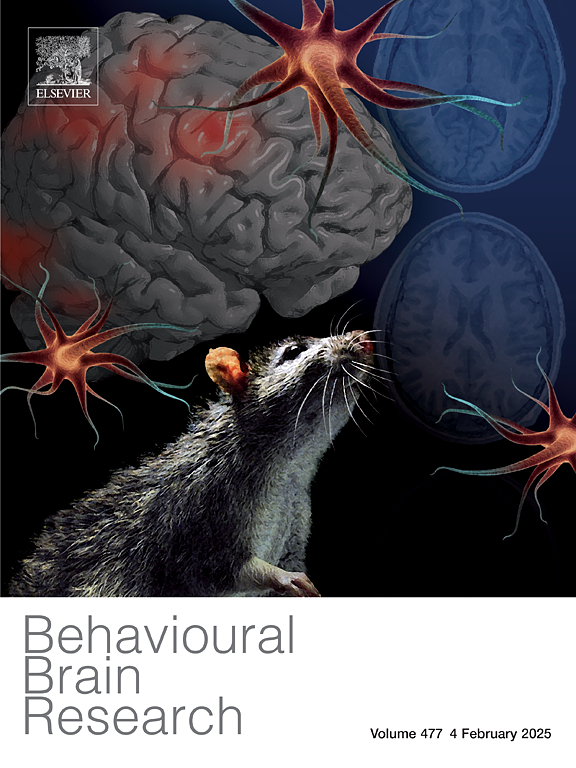Neuroanatomical basis of 5-HT1A receptor agonism in disruption of maternal behavior in rats
IF 2.6
3区 心理学
Q2 BEHAVIORAL SCIENCES
引用次数: 0
Abstract
The acute activation of serotonin 1 A (5-HT1A) receptors appears to disrupt maternal behavior in rats; however, the underlying neuroanatomical mechanisms remain poorly understood. We employed two approaches to investigate the role of 5-HT1A receptors in maternal behavior to address this knowledge gap. First, we used real-time polymerase chain reaction (PCR) to analyze 5-HT1A receptor mRNA expression in female rats at different reproductive stages. We identified stage- and region-specific expression patterns, including temporary increases in the nucleus accumbens (NAc), ventral tegmental area (VTA), and dorsal raphe nucleus (DRN), as well as a temporary decrease in the medial prefrontal cortex (mPFC), amygdala, hippocampus, and ventromedial hypothalamic nucleus (VMH) during the perinatal, early, and middle postpartum periods. These findings suggest that coordinated 5-HT1A activity across these brain regions is critical for normal maternal behavior. Second, we used c-Fos immunohistochemistry to elucidate the central mechanisms underlying the effects of the acute and repeated administration of 8-OH-DPAT (a 5-HT1A receptor agonist, 1.0 mg/kg, sc.) on maternal behavior. Acute 8-OH-DPAT administration disrupted maternal behaviors, including pup retrieval, pup licking, nest building and hovering over pups, while simultaneously increased c-Fos expression in the mPFC, ventral bed nucleus of the stria terminalis (vBNST), NAc shell, lateral septum (LS), and medial amygdala (MeA). Disruptions in pup retrieval, pup licking and nest building persisted following five days of repeated 8-OH-DPAT treatment, whereas hovering over pups showed substantial recovery, returning to near-normal levels. Concurrently, c-Fos expression increased in the vBNST but decreased in the mPFC, MeA, and DRN. These results suggest that acute and repeated 8-OH-DPAT administration disrupts maternal behavior via distinct presynaptic and postsynaptic 5-HT1A receptor mechanisms. This study highlights the complex regulatory role of 5-HT1A receptor activity in maternal care and provides insights into the neuroanatomical and neurochemical mechanisms underlying maternal behavior.
5-HT1A受体激动作用在大鼠母性行为破坏中的神经解剖学基础
血清素1 A (5-HT1A)受体的急性激活似乎会破坏大鼠的母性行为;然而,潜在的神经解剖学机制仍然知之甚少。我们采用两种方法来研究5-HT1A受体在母体行为中的作用,以解决这一知识差距。首先,我们利用实时聚合酶链反应(real-time polymerase chain reaction, PCR)分析了不同生殖阶段雌性大鼠5-HT1A受体mRNA的表达。我们确定了特定阶段和区域的表达模式,包括伏隔核(NAc)、腹侧被盖区(VTA)和中叶背核(DRN)的暂时增加,以及内侧前额皮质(mPFC)、杏仁核、海马和腹内侧下丘脑核(VMH)在围产期、产后早期和中期的暂时减少。这些发现表明,在这些大脑区域协调的5-HT1A活动对正常的母性行为至关重要。其次,我们使用c-Fos免疫组织化学来阐明急性和反复给药8-OH-DPAT(一种5-HT1A受体激动剂,1.0 mg/kg, sc.)对母体行为影响的核心机制。8- o - dpat的急性给药破坏了母鼠的行为,包括幼鼠的取崽、舔崽、筑巢和在幼鼠周围盘旋,同时增加了mPFC、终纹腹床核(vBNST)、NAc壳、外侧隔(LS)和内侧杏仁核(MeA)中c-Fos的表达。在重复8-OH-DPAT治疗5天后,幼犬的回收,幼犬舔舐和筑巢的中断仍然存在,而徘徊在幼犬身上则显示出明显的恢复,恢复到接近正常水平。同时,c-Fos在vBNST中表达增加,而在mPFC、MeA和DRN中表达减少。这些结果表明,急性和重复给药8-OH-DPAT通过不同的突触前和突触后5-HT1A受体机制破坏母体行为。本研究强调了5-HT1A受体活性在产妇护理中的复杂调节作用,并为产妇行为背后的神经解剖学和神经化学机制提供了见解。
本文章由计算机程序翻译,如有差异,请以英文原文为准。
求助全文
约1分钟内获得全文
求助全文
来源期刊

Behavioural Brain Research
医学-行为科学
CiteScore
5.60
自引率
0.00%
发文量
383
审稿时长
61 days
期刊介绍:
Behavioural Brain Research is an international, interdisciplinary journal dedicated to the publication of articles in the field of behavioural neuroscience, broadly defined. Contributions from the entire range of disciplines that comprise the neurosciences, behavioural sciences or cognitive sciences are appropriate, as long as the goal is to delineate the neural mechanisms underlying behaviour. Thus, studies may range from neurophysiological, neuroanatomical, neurochemical or neuropharmacological analysis of brain-behaviour relations, including the use of molecular genetic or behavioural genetic approaches, to studies that involve the use of brain imaging techniques, to neuroethological studies. Reports of original research, of major methodological advances, or of novel conceptual approaches are all encouraged. The journal will also consider critical reviews on selected topics.
 求助内容:
求助内容: 应助结果提醒方式:
应助结果提醒方式:


